brake HONDA PRELUDE 1998 Owners Manual
[x] Cancel search | Manufacturer: HONDA, Model Year: 1998, Model line: PRELUDE, Model: HONDA PRELUDE 1998Pages: 278, PDF Size: 2.61 MB
Page 50 of 278

Instruments and Controls
This section gives information about the controls and displays that
contribute to the daily operation of
your Honda. All the essential controls are within easy reach.
Control Locations............................ 50
Indicator Lights................................ 51
Gauges.............................................. 56
Speedometer................................ 56
Tachometer.................................. 56
Odometer...................................... 56
Trip Meter.................................... 56
Fuel Gauge................................... 57
Temperature Gauge.................... 57 Maintenance Required Indicator.................................... 58
Controls Near the Steering
Wheel........................................ 59
Headlights.................................... 60
Daytime Running Lights............. 60
Instrument Panel Brightness..... 61
Turn Signals................................. 61
Windshield Wipers...................... 62
Windshield Washers................... 63
Hazard Warning........................... 63
Rear Window Defogger.............. 63
Steering Wheel Adjustment....... 64
Steering Wheel Controls ................ 65
Cruise Control.............................. 65
Keys and Locks................................ 68
Keys...............................................68
Learning Key................................ 69
Immobilizer System..................... 69
Ignition Switch............................. 70
Power Door Locks....................... 72
Lockout Prevention..................... 73
Trunk............................................73
Glove Box.....................................74
Seat Adjustments............................. 75 Front Seat Adjustments.............. 75Driver's Seat Height Adjustment............................... 76
Rear Seat Access .........................
76
Head Restraints...........................
77
Seat Heaters..................................... 78
Folding Rear Seat............................ 79
Power Windows............................... 80
Moonroof..........................................82
Mirrors.............................................. 83
Adjusting the Power Mirrors.....
83
Parking Brake..................................
84
Digital Clock..................................... 85
Beverage Holder.............................. 86 Console Compartment.................... 87
Coin Box........................................... 88
Accessory Power Socket................ 88
Ashtrays............................................ 89
Interior Lights.................................. 89 Ceiling Lights............................... 89
Courtesy Lights........................... 90
Instruments and ControlsProCarManuals.comMain Menu s t
Page 52 of 278

Indicator Lights
The instrument panel has many indicators to give you important
information about your vehicle.
Lamp Chec
k
These indicator lights come on when you turn the ignition switch ON (II), allowin
g you to see that they are
working:
SRS
Indicator
Malfunction Indicator Lamp
Charging System Indicator Low Oil Pressure Indicator
Anti-lock Brake System Indicator
Seat Belt Reminder Light
D4 Lamp
Immobilizer System Indicator
Active Torque Transfer
System
Indicator
If an
indicator does not light during
this test, it cannot alert you if that system
develops a problem. Have the
dealer check your vehicle for
burned-ou
t bulbs or other problems.
* The
U.S. instrument panel is shown. Differences for the Canadian model
are
noted in the text.
Instruments
and Controls
MALFUNCTION
INDICATOR LAM
P
TRUNK-OPEN INDICATOR
SUPPLEMENTAL
RESTRAINT
SYSTEM
INDICATOR
DOOR-OPEN
INDICATOR
PARKING BRAKE AND
BRAKE SYSTEM INDICATOR*
ANTI-LOCK BRAKE SYSTEM INDICATOR*
IMMOBILIZER
SYSTEM INDICATOR
LOW OIL PRESSURE
INDICATOR
SEAT BELT
REMINDER LIGHT LOW
FUEL
INDICATOR
CHARGING SYSTEM
INDICATOR
HIGH
BEAM
INDICATOR
CRUISE CONTRO L
INDICATOR
ProCarManuals.comMain Menu Table of Contents s t
Page 53 of 278
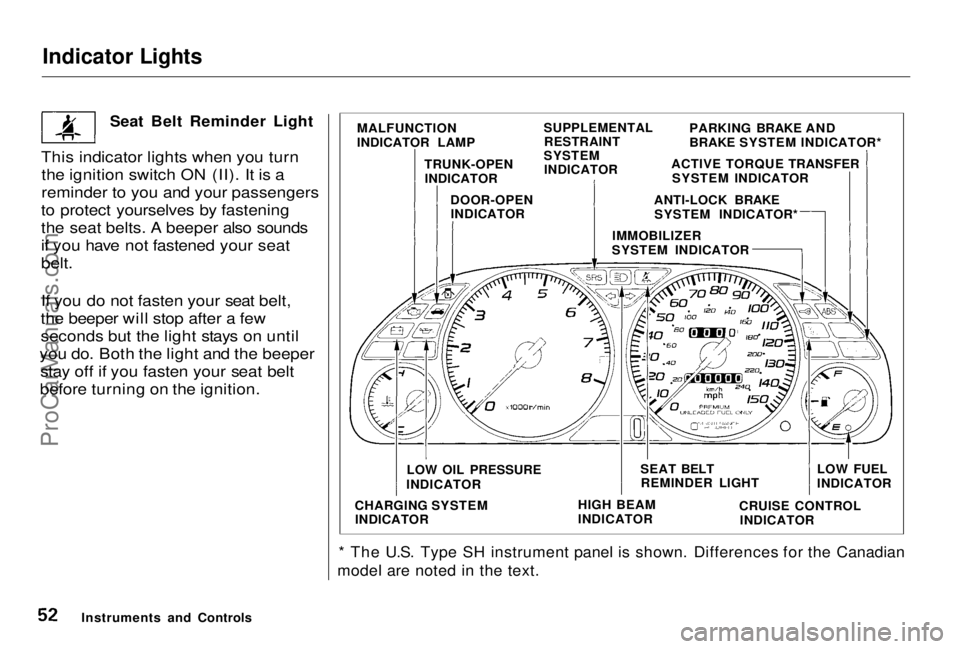
Indicator Lights
Seat Belt Reminder Light
This indicator lights when you turn the ignition switch ON (II). It is a
reminder to you and your passengers
to protect yourselves by fastening
the seat belts. A beeper also sounds
if you have not fastened your seat
belt.
If you do not fasten your seat belt,
the beeper will stop after a few
seconds but the light stays on until
you do. Both the light and the beeper stay off if you fasten your seat belt
before turning on the ignition.
* The U.S. Type SH instrument panel is shown. Differences for the Canadian
model are noted in the text.
Instruments and Controls MALFUNCTION
INDICATOR LAMP
SUPPLEMENTAL
RESTRAINT
SYSTEM INDICATOR
TRUNK-OPEN
INDICATOR
DOOR-OPENINDICATOR PARKING BRAKE AND
BRAKE SYSTEM INDICATOR*
ACTIVE TORQUE TRANSFER SYSTEM INDICATOR
ANTI-LOCK BRAKE SYSTEM INDICATOR*
IMMOBILIZER
SYSTEM INDICATOR
LOW OIL PRESSURE
INDICATOR
CHARGING SYSTEM INDICATOR SEAT BELT
REMINDER LIGHT
HIGH BEAM
INDICATOR LOW FUEL
INDICATOR
CRUISE CONTROL INDICATORProCarManuals.comMain Menu Table of Contents s t
Page 54 of 278
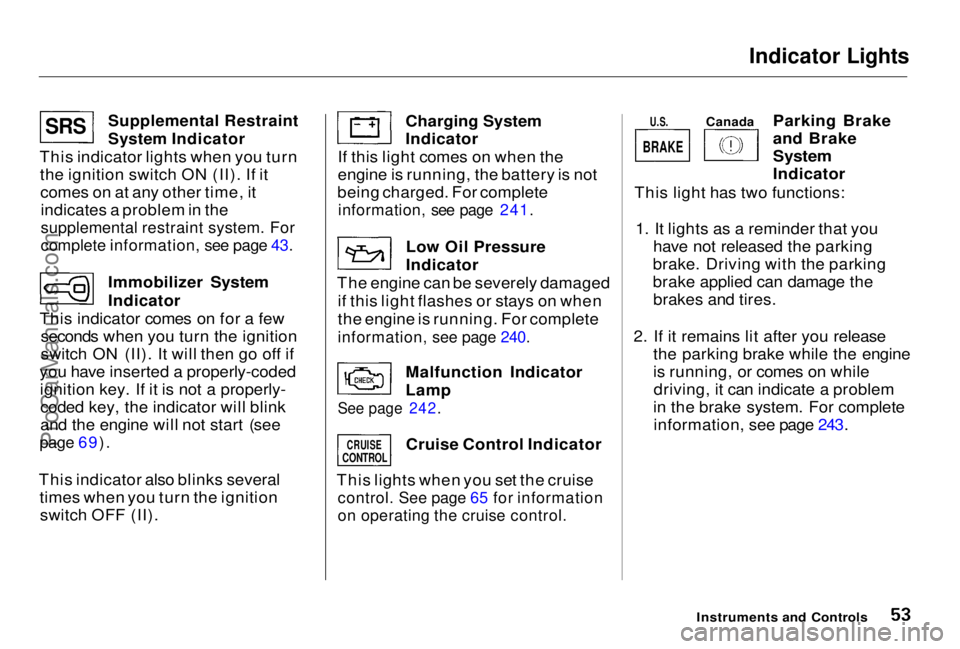
Indicator Lights
Supplemental Restraint
System Indicator
This indicator lights when you turn the ignition switch ON (II). If itcomes on at any other time, itindicates a problem in the
supplemental restraint system. For
complete information, see page 43.
Immobilizer System
Indicator
This indicator comes on for a few seconds when you turn the ignition
switch ON (II). It will then go off if
you have inserted a properly-coded ignition key. If it is not a properly-coded key, the indicator will blink
and the engine will not start (see
page 69).
This indicator also blinks several times when you turn the ignitionswitch OFF (II). Charging System
Indicator
If this light comes on when the
engine is running, the battery is not
being charged. For complete
information, see page 241.
Low Oil Pressure
Indicator
The engine can be severely damaged if this light flashes or stays on when
the engine is running. For complete
information, see page 240.
Malfunction Indicator
Lamp
See page 242.
Cruise Control Indicator
This lights when you set the cruise
control. See page 65 for information
on operating the cruise control.
Parking Brake
and Brake
System
Indicator
This light has two functions:
1. It lights as a reminder that you have not released the parking
brake. Driving with the parking
brake applied can damage the brakes and tires.
2. If it remains lit after you release the parking brake while the engine
is running, or comes on whiledriving, it can indicate a problem
in the brake system. For complete information, see page 243.
Instruments and Controls
S R S
BRAKE
CRUISE
CONTROL
U.S.
Canada
ProCarManuals.comMain Menu Table of Contents s t
Page 55 of 278

Indicator Lights
Anti-lock BrakeSystem (ABS)
Indicator
This light normally comes on for a few seconds when you turn the
ignition switch ON (II), and when
the ignition switch is turned to
START (III). If this light comes on at
any other time, there is a problem in
the ABS. If this happens, take the
vehicle to your dealer to have it checked. With the light on, your
vehicle still has normal braking ability but no anti-lock. Active Torque Transfer
System (ATTS) Indicator
Type SH only
This indicator normally comes on for a few seconds when you turn the
ignition switch ON (II).
If it comes on at any other time,
there is a problem in the Active
Torque Transfer System (ATTS). If this happens, take the vehicle to
your dealer to have it checked. With the indicator on, your vehicle willcorner normally, but you will not
have active torque transfer. Turn Signal and
Hazard Warning
Indicators
The left or right turn signal light blinks when you signal a lane changeor turn. If the light does not blink or
blinks rapidly, it usually means one of the turn signal bulbs is burned out (see page 210). Replace the bulb as
soon as possible, since other drivers
cannot see that you are signalling.
When you turn on the Hazard Warning switch, both turn signallights blink. All turn signals on the
outside of the vehicle should flash.
Instruments and Controls
ABS
ATTS
U.S.
CanadaProCarManuals.comMain Menu Table of Contents s t
Page 56 of 278
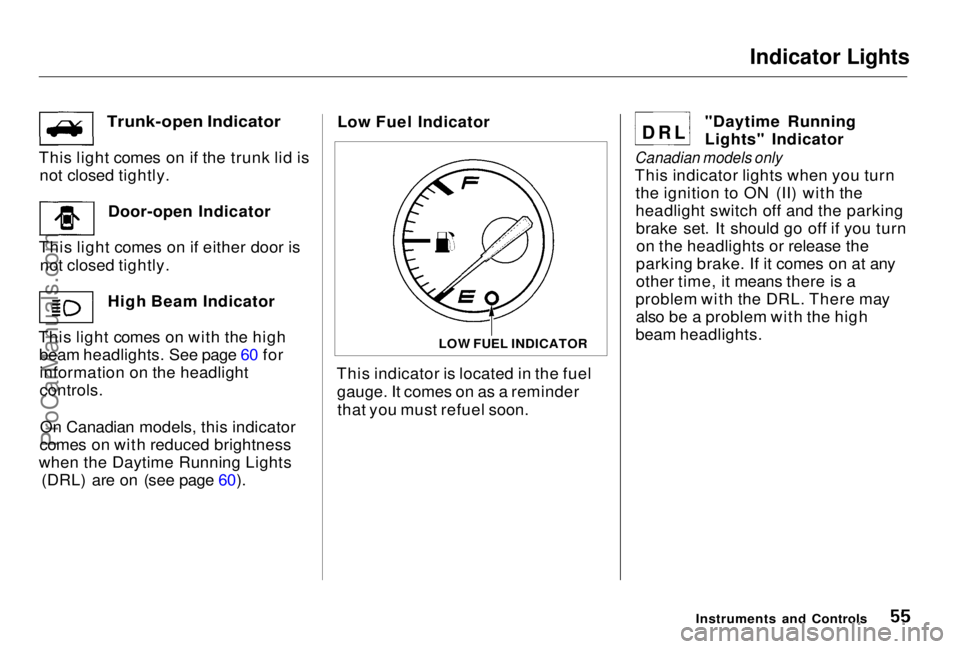
Indicator Lights
Trunk-open Indicator
This light comes on if the trunk lid is not closed tightly.
Door-open Indicator
This light comes on if either door is not closed tightly.
High Beam Indicator
This light comes on with the high beam headlights. See page 60 forinformation on the headlight
controls.
On Canadian models, this indicator
comes on with reduced brightness
when the Daytime Running Lights (DRL) are on (see page 60). Low Fuel Indicator
This indicator is located in the fuel gauge. It comes on as a reminderthat you must refuel soon. "Daytime Running
Lights" Indicator
Canadian models only
This indicator lights when you turn the ignition to ON (II) with the
headlight switch off and the parkingbrake set. It should go off if you turnon the headlights or release the
parking brake. If it comes on at any
other time, it means there is a
problem with the DRL. There may also be a problem with the high
beam headlights.
Instruments and Controls
D
R
L
LOW FUEL INDICATORProCarManuals.comMain Menu Table of Contents s t
Page 61 of 278
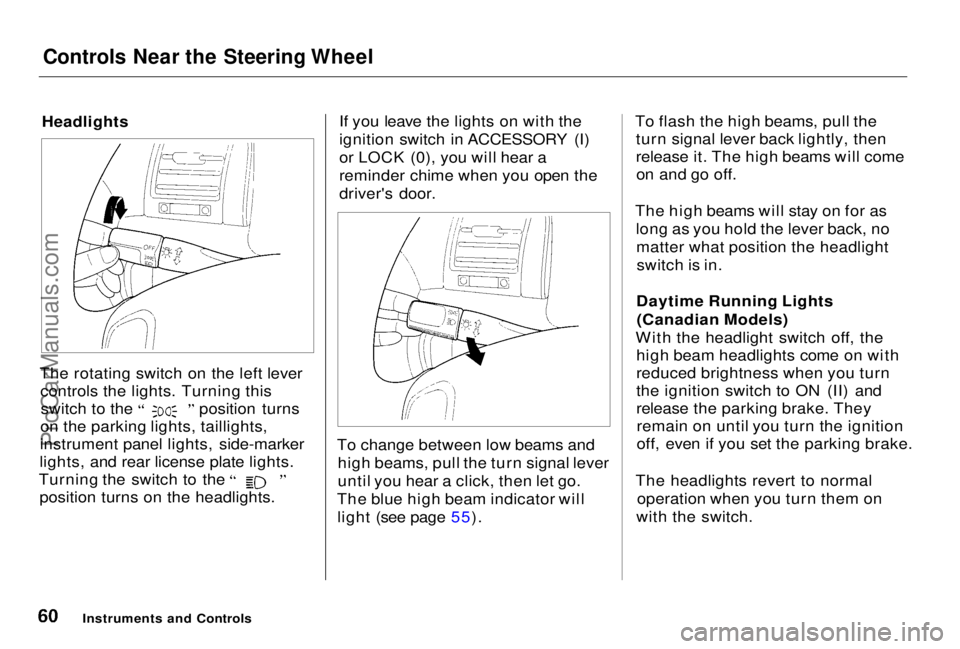
Controls Near the Steering Wheel
Headlights
The rotating switch on the left lever controls the lights. Turning this switch to the position turns
on the parking lights, taillights,
instrument panel lights, side-marker
lights, and rear license plate lights. Turning the switch to the
position turns on the headlights. If you leave the lights on with the
ignition switch in ACCESSORY (I)
or LOCK (0), you will hear a
reminder chime when you open the
driver's door.
To change between low beams and high beams, pull the turn signal lever
until you hear a click, then let go.
The blue high beam indicator will light (see page 55). To flash the high beams, pull the
turn signal lever back lightly, then
release it. The high beams will comeon and go off.
The high beams will stay on for as long as you hold the lever back, nomatter what position the headlightswitch is in.
Daytime Running Lights (Canadian Models)
With the headlight switch off, the high beam headlights come on with
reduced brightness when you turn
the ignition switch to ON (II) and
release the parking brake. Theyremain on until you turn the ignition
off, even if you set the parking brake.
The headlights revert to normal operation when you turn them on
with the switch.
Instruments and ControlsProCarManuals.comMain Menu Table of Contents s t
Page 67 of 278

Steering Wheel Controls
3. Press and hold the SET/decel button on the steering wheel until
the CRUISE CONTROL light on
the instrument panel comes on.
This shows the system is now
activated.
The cruise control may not hold the set speed when you are going
up and down hills.
When climing a steep hill, the automatic transmission may
downshift to hold the set speed. Changing the Set Speed
You can increase the set cruising
speed in either of two ways: Press and hold the RESUME/
accel button. The vehicle will
accelerate slowly. When you reach
the desired cruising speed, release
the button. Push on the accelerator pedal. Ac-
celerate to the desired cruising
speed and press the SET/decel
button.
You can decrease the set cruising
speed in either of two ways: Press and hold the SET/decel
button. The vehicle will decelerate. Release the button when you
reach the desired speed.
Tap the brake or clutch pedal lightly with your foot. TheCRUISE CONTROL light on the
instrument panel will go out.
When the vehicle slows to the desired speed, press the SET/
decel button. The vehicle will then
maintain the desired speed.
Instruments and Controls RESUME/
accel
SET/decelProCarManuals.comMain Menu Table of Contents s t
Page 68 of 278
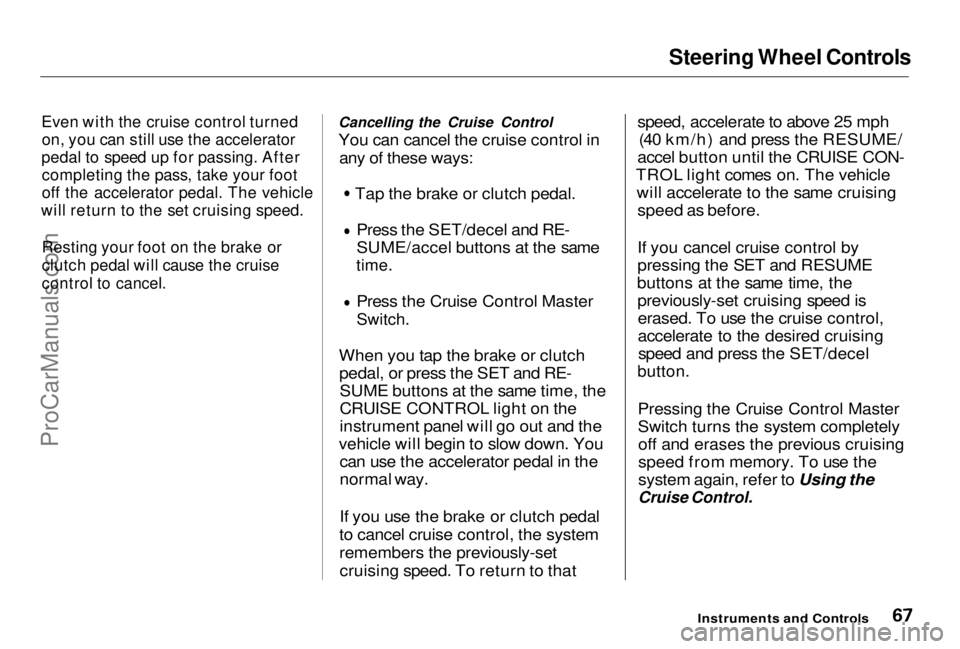
Steering Wheel Controls
Even with the cruise control turned on, you can still use the accelerator
pedal to speed up for passing. After
completing the pass, take your foot
off the accelerator pedal. The vehicle
will return to the set cruising speed.
Resting your foot on the brake or
clutch pedal will cause the cruise
control to cancel.
Cancelling the Cruise Control
You can cancel the cruise control in
any of these ways:
Tap the brake or clutch pedal. Press the SET/decel and RE-
SUME/accel buttons at the same
time.
Press the Cruise Control Master
Switch.
When you tap the brake or clutch pedal, or press the SET and RE-SUME buttons at the same time, the
CRUISE CONTROL light on the
instrument panel will go out and the
vehicle will begin to slow down. You can use the accelerator pedal in the
normal way.
If you use the brake or clutch pedal
to cancel cruise control, the system
remembers the previously-set cruising speed. To return to that speed, accelerate to above 25 mph
(40 km/h) and press the RESUME/
accel button until the CRUISE CON-
TROL light comes on. The vehicle will accelerate to the same cruisingspeed as before.
If you cancel cruise control by
pressing the SET and RESUME
buttons at the same time, the previously-set cruising speed iserased. To use the cruise control,
accelerate to the desired cruisingspeed and press the SET/decel
button.
Pressing the Cruise Control Master
Switch turns the system completelyoff and erases the previous cruising
speed from memory. To use the
system again, refer to Using the
Cruise Control.
Instruments and ControlsProCarManuals.comMain Menu Table of Contents s t
Page 81 of 278

Folding Rear Seat, Power Windows
Make sure both rear shoulder belts are positioned in front of the rear
seat-back whenever the seat-back is
in its upright position.
Make sure all items in the trunk, or
items extending through the opening
into the back seat, are tied down.
Loose items can fly if you have to
brake hard. See Carrying Cargo on
page 128.
Never drive with the seat-back
folded down and the trunk lid open.
See Carbon Monoxide Hazard on
page 47. Power Windows
Your vehicle's windows are electri- cally-powered. Turn the ignitionswitch to ON (II) to raise or lower
any window.
Each door has a switch that controls
its window. To open the window,
push the switch down and hold it.
Release the switch when you want
the window to stop. Close the
window by pulling back on the switch and holding it.
The driver's armrest has a masterpower window control panel. To
open the passenger's window, push
down on the switch and hold it down
until the window reaches the desired
position. To close the window, pull
back on the window switch. Release
the switch when the window gets to
the position you want.
Instruments and Controls
DRIVER'S WINDOW
SWITCH
MAIN
SWITCHProCarManuals.comMain Menu Table of Contents s t